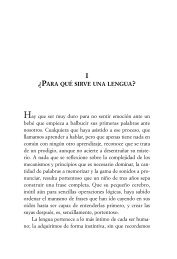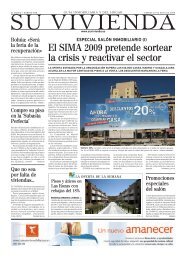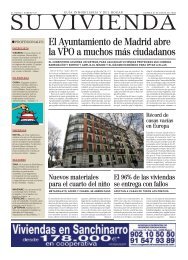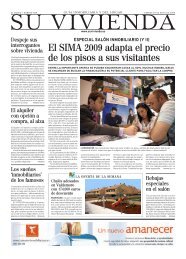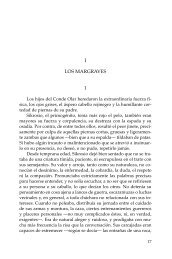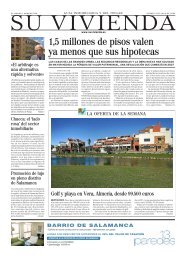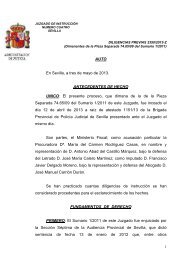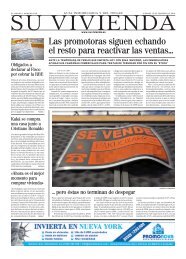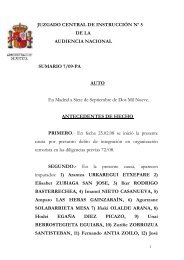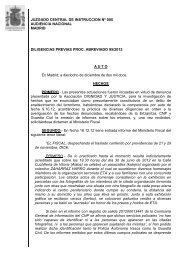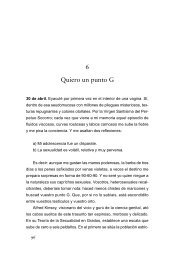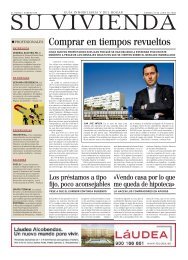UNIDAD 7: Spain, Europe and the World - El Mundo
UNIDAD 7: Spain, Europe and the World - El Mundo
UNIDAD 7: Spain, Europe and the World - El Mundo
Create successful ePaper yourself
Turn your PDF publications into a flip-book with our unique Google optimized e-Paper software.
THINK<br />
If you see this film, make a list of all <strong>the</strong> characters <strong>and</strong> describe <strong>the</strong>m briefly: what <strong>the</strong>y are<br />
like, what <strong>the</strong>y do, how <strong>the</strong>y behave.<br />
- What could be done to stop <strong>the</strong> injustice caused by <strong>the</strong> economic interests on an international<br />
level, as happens with <strong>the</strong> pharmaceutical industry in this film?<br />
- Research some o<strong>the</strong>r examples of international economic involvement. Where were <strong>the</strong> cars<br />
we use made? Where were <strong>the</strong> trainers you wear made?<br />
7.6.- Looking through Images: Santiago Calatrava<br />
Economy <strong>and</strong> politics are not <strong>the</strong> only ways countries make <strong>the</strong>mselves known<br />
worldwide, art is also important. Our country is well known within many artistic disciplines.<br />
One of <strong>the</strong>m, related to <strong>the</strong> present day, is architecture. It is not a minor art; it combines<br />
pragmatic <strong>and</strong> aes<strong>the</strong>tic values. Creating spaces for citizenship is not just a metaphor;<br />
architecture makes space inhabitable <strong>and</strong> human. Santiago Calatrava is one of <strong>the</strong> most<br />
important Spanish architects. His characteristic view of architecture makes him one of <strong>the</strong><br />
most creative <strong>and</strong> original architects.<br />
He was born in Benimàmet (Valencia) on <strong>the</strong> 28 th July 1951;<br />
his family worked in <strong>the</strong> export of citrus fruit, which allowed<br />
him to travel to o<strong>the</strong>r <strong>Europe</strong>an countries. He studied<br />
Architecture in Valencia. He also studied civil engineering for<br />
four years in Zurich, at <strong>the</strong> Federal Institute of Technology. He<br />
has been awarded several prizes, including <strong>the</strong> Príncipe de<br />
Asturias Prize in 1999.<br />
“Turning Torso” is one of Santiago Calatrava's most important works. It is a 190metre<br />
high <strong>and</strong> 54-floor residential skyscraper in Malmö (Sweden). It is <strong>the</strong> highest<br />
residential building in Sweden, <strong>and</strong> <strong>the</strong> second highest in <strong>Europe</strong> (on <strong>the</strong> day it was<br />
inaugurated). It was inaugurated on <strong>the</strong> 27 th of August 2005, <strong>and</strong> its construction<br />
took four years. As its name indicates, <strong>the</strong> author got his inspiration from a human<br />
torso turning 90 degrees from <strong>the</strong> bottom to <strong>the</strong> top. The building is made of steel,<br />
glass <strong>and</strong> reinforced concrete. It consists of nine rotary cubes <strong>and</strong> <strong>the</strong>ir main<br />
structural element is a reinforced concrete core. The outside of <strong>the</strong> building is<br />
covered with glass <strong>and</strong> aluminium panels. There are six floors to each cube.<br />
CIUDAD DE LAS ARTES Y DE LAS CIENCIAS (Valencia)<br />
10



